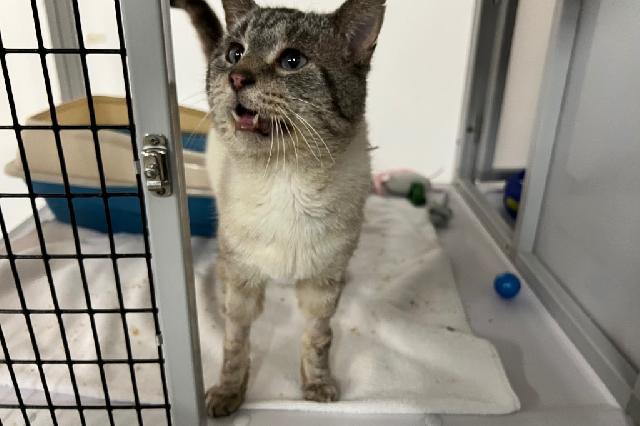Have you spied a stray cat in your yard? Catch a colony of feral cats by your building? Here are essential guidelines for working with stray or feral cats.
What’s the difference between a stray and feral cat?
Stray cats are socialized to people and are eligible for adoption, while feral cats aren’t domesticated and are happy living outside on their own. Feral cats are also less likely to approach people, unlike strays, who are more comfortable around humans and houses.
Strays should be caught and brought to shelters to help reunite them with families or find new homes for them. Ferals should be captured and released after being fixed.
What can I do to help a stray cat?
If a cat comes to your property, it may be lost. Cats that were previously in a home are often scared. Use caution, keep your voice quiet and move slowly when you approach the cat.
If you can get the cat into a carrier, take it to a veterinary clinic to check for a microchip. The veterinary clinic will contact the microchip company and then the owner to claim their cat. If you cannot capture the cat, you can try to find the owners yourself. Create found cat posts and flyers then share them in your community. When responding to inquiries, make sure to ask potential owners open-ended questions, like “What does your cat’s tail look like?” so you can find the kitty’s rightful owners.
Should I feed a stray cat?
Feeding a stray cat will likely make it your cat. Scared and lost cats will enjoy coming back to your home as a source of food. We strongly recommend going beyond feeding stray cats and reaching out to a veterinarian and no-kill shelter to ensure the cat is healthy and safe. If you choose to feed the cat, opt for wet cat food or tuna. Be sure to keep dry food out only during the day to prevent unwanted visitors like possums or raccoons at night.
Should I feed feral cats?
Like stray cats, feed feral cats if they look malnourished. However, a feral cat’s behavior will differ from a stray – it will most likely wait for you to leave before eating. It will also not warm up to you after frequent feedings as a stray cat would.
Feral cats will very likely bring other cats from their colony to your doorstep to eat as well. Because feral cats are not accustomed to interacting with people, there’s a higher risk of property damage to your porch or property when they come to feed. However, because they aren’t adoptable, they can greatly benefit from access to food beyond hunting.
When considering feeding stray and feral cats, be sure the area is safe for the animals and your personal boundaries. Regularly feeding strays and feral cats without spaying/neutering may result in overpopulation and be a possible nuisance to you and your neighbors.
How do I catch feral cats?
Never try to pick up a feral cat – your best move is to lure it into a safe trap so professionals can neuter/spay and vaccinate him or her (more commonly known as TNVR). Rent a trap for a low fee, set up a consultation, and ask questions with Gina, SAFE Haven Community Outreach Coordinator, via email at gina@safehavenforcats.org. You can also visit SAFE Care Spay/Neuter Clinic’s resources page for additional resources.
Can I adopt a stray cat?
When approaching a stray cat, think LOST, not stray. If you’ve posted found cat advertisements and checked with your vet for a microchip to no avail, over time the cat may become comfortable enough to live with you full-time. Ensure the cat is neutered or spayed and vaccinated. Slowly let the cat re-acclimate to being indoors and under the care of people again.
If the cat finds its owner again and you’re looking to adopt, visit shelters like SAFE Haven to adopt cats that are looking for a home in the Triangle.
What is TNVR?
Trap-neuter-vaccinate-release (TNVR) is the most humane service for feral cats.
Feral cats aren’t socialized and cannot be adopted. This means when the cats are brought to a county shelter, they will be euthanized. TNVR helps reduce mating behaviors like fighting and pregnancy that result in illness or injury. By stopping the breeding cycle in feral cat colonies, TVNR promotes ending cat overpopulation and ultimately saving cats from disease and euthanization.
SAFE Haven Spay/Neuter Clinic now offers TNVR services for feral cats in the Triangle. For more information, visit their website.
How do I set up a trap for TNVR?
- Make an appointment at SAFE Haven Spay/Neuter Clinic or your local no-kill clinic that offers TNVR services. Many clinics do not accept walk-in appointments, so it is best to reserve a spot prior to trapping.
- If you do not own a trap, call SAFE Haven at 919-872-7730 to rent one.
- Stop feeding 24 hours before setting the trap. Notify neighbors around you who also provide food to stop feeding as well.
- Set the traps in the area where the cats typically eat and bait them with strong-smelling food such as wet cat food, tuna, or sardines. Stay out of sight, but be sure to check on them in hot, cold, or rainy weather.
- Once a cat is trapped, cover the trap with an old sheet or towel and move it to a safe place. Take the cat to the clinic – once its procedures are complete, it should stay in its trap for another 24 hours before being released to its colony.


